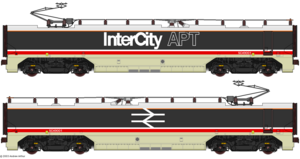User:Hammersfan/Railway Adjustment and Intervention Bureau/British Rail Class 370
| British Rail Class 370 (Advanced Passenger Train–Prototype) | |
|---|---|
 370 003 at Carlisle | |
| In service | 1980- |
| Manufacturer | BREL |
| Family name | APT |
| Number built | 4 trainsets |
| Formation | 14 cars per trainset |
| Operators | Virgin Trains |
| Lines served | West Coast Main Line |
| Specifications | |
| Height | 3.5 m (11 ft) |
| Maximum speed | 155 mph (249 km/h) (Design) 125 mph (201 km/h) (service) |
| Weight | 434 tonnes (427 long tons) |
| Electric system(s) | 25 kV AC Overhead |
| UIC classification | 2'2'2'2'2'2'2'+Bo'Bo'+Bo'Bo'+2'2'2'2'2'2'2' |


The Class 370 is an electric multiple unit first operated by British Rail. The type was a pioneer of a number of new technologies, including tilt capability.
History
[edit]British Rail
[edit]British Rail's Class 370 tilting trains, also referred to as APT-P (meaning Advanced Passenger Train Prototype), were the pre-production Advanced Passenger Train units. Unlike the earlier experimental gas-turbine APT-E unit, these units were powered by 25kV AC overhead electrification and were used on the West Coast Main Line between London Euston and Glasgow Central. The APT-P is the most powerful domestic train to have operated in Britain, the eight traction motors fitted to the two central Motor Cars giving a total output of 8,000 horsepower (6,000 kW). This enabled the train to set the UK rail speed record of 162.2 miles per hour (261.0 km/h) in December 1979, a record that stood for 23 years.[1]
Despite some initial bad publicity on the first trial run in December 1981, the Class 370 units were successfully introduced into revenue earning service early in 1982 on the WCML. To promote the new trains, the Class 370 was used on the WCML's flagship Royal Scot service between Euston and Glasgow Central from June 1982. This, combined with the improvement in the timetable thanks to both the speed and tilt mechanism, led to increasing numbers opting to use the train on WCML routes. In addition to the flagship Glasgow service, the Class 370 was also used on services to Manchester Piccadilly from early 1983.
The success of the first three Class 370 units led to InterCity opting to build a fourth train using the spare driving car, which entered service in 1986. However, at that time, the British government had made the decision to electrify the East Coast Main Line, meaning that British Rail's resources were diverted to that project. As a consequence, the planned production series units, which had received the TOPS classification Class 372, were put on hold in favour of new trains for the ECML. Once this was complete, the intention was to undertake an upgrade to the WCML to make the most of the APT's capabilities, which would see the construction of a production batch. The recession of the early 1990s meant that, owing to the requirement for new rolling stock for Network SouthEast, the WCML project, along with the planned Class 372 trains, was cancelled.
Privatisation
[edit]Following the Privatisation of British Rail in the mid 1990s, the eight Class 370 half-sets were passed to the new operator on the WCML, Virgin Trains. To ensure that the maintenance cost of such a small fleet could be kept down, the Asea LJMA410F traction motors originally installed were replaced by GEC units used in the Class 91 locomotive. This work began prior to the start of the new franchise, with Virgin contributing the cost while the InterCity West Coast shadow franchise undertook the work. This was completed in time for the handover of the operation to Virgin in 1997, with ownership passing to the newly formed ROSCO Angel Trains. At the same time, Virgin made a £1bn rolling stock order for 53 brand new trains, which became the Class 390 Pendolino, which would incorporate the tilt technology from the Class 370. The Class 370 units were retained on flagship WCML services until 2004, by which time sufficient Class 390 units had been delivered to allow replacement of the locomotive hauled services. The Class 370s were then cascaded to other services, mainly between Glasgow Central and Birmingham New Street, to supplement Virgin's other new rolling stock.
Operations
[edit]The four Class 370 units are currently used mainly on services between Birmingham New Street and Glasgow Central/Edinburgh Waverley during peak time. The units are also used on relief services from London Euston when additional capacity is required; this is primarily on a Fridays only service between Euston and Preston.
Fleet Details
[edit]| Class | Operator | No. Built | Year Built | Cars per Set | Unit nos. | Notes |
|---|---|---|---|---|---|---|
| Class 370 | Virgin Trains | 3 (6 half-sets) | 1979-1980 | 14 | 370001 - 370006 | |
| 1 (2 half-sets) | 1986 | 370007 - 370008 |
Numbering
[edit]Units were numbered 370001-370008 and were formed as follows:
- 48101-48108 - Driving Trailer Second
- 48201-48208 - Trailer Second
- 48401-48408 - Trailer Restaurant Second Buffet
- 48301-48308 - Trailer Unclassified
- 48501-48508 - Trailer First
- 48601-48608 - Trailer Brake First
- 49001-49008 - Non-Driving Motor
A full train is made up of two units running back-to-back, with the two motor cars adjoining. The motor cars had no seating accommodation or through-gangway, so the two halves of the train were unconnected for passengers.
See also
[edit]References
[edit]- ^ "Train smashes speed record". BBC News. 2003-07-30. Retrieved 2010-06-02.
